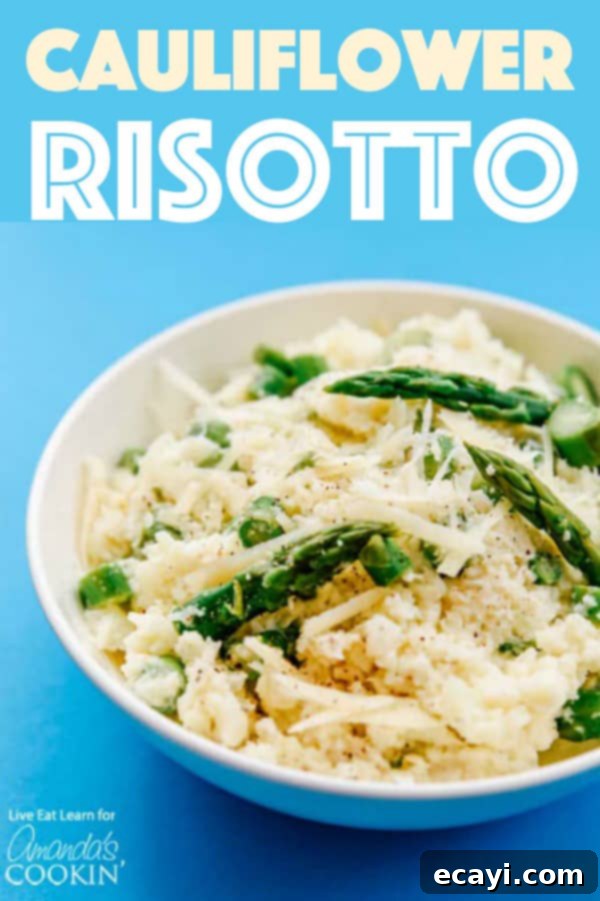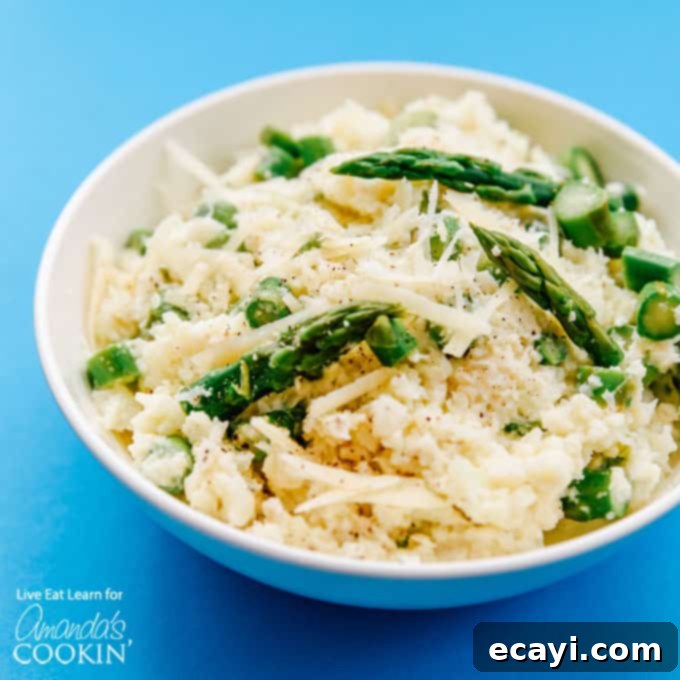Creamy & Healthy Low-Carb Cauliflower Risotto: Your Guilt-Free Italian Favorite!
This Cauliflower Risotto offers a truly delicious and satisfying low-carb twist on the beloved classic Italian dish. It delivers all the creamy, cheesy goodness you crave from traditional risotto, but with a lighter, healthier profile that’s completely guilt-free. Perfect for anyone looking to enjoy rich flavors without the heavy carb load, this recipe is both easy to prepare and incredibly flavorful.
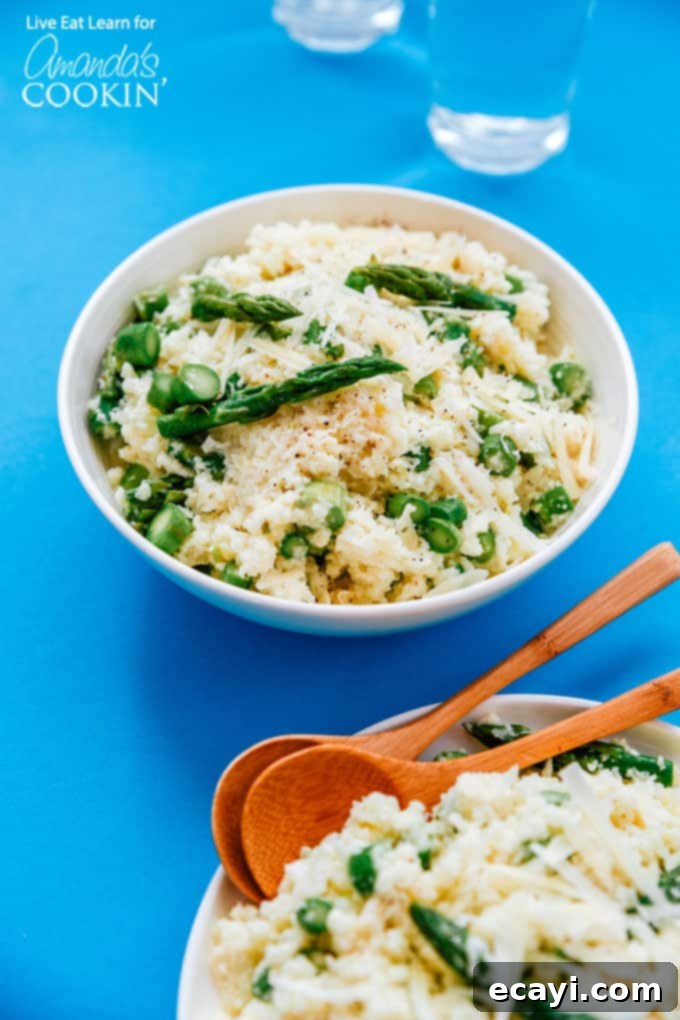
Embrace the Revolution: Why Cauliflower Risotto is Your New Go-To
I’m an undeniable fan of risotto. Who isn’t? Its creamy texture, comforting warmth, and incredible versatility make it a perennial favorite. You can easily customize it with whatever fresh ingredients you happen to have on hand, transforming simple arborio rice into a gourmet experience. However, I’d be less than honest if I didn’t acknowledge some of the downsides of traditional risotto.
For starters, it can feel like it takes an eternity to prepare. The conventional method requires slowly adding broth, ladle by ladle, over the course of 30 minutes or more. This means you’re often tethered to the stovetop, stirring almost constantly, which isn’t always ideal for a busy weeknight. Beyond the time commitment, traditional risotto, while delicious, isn’t always the healthiest option. It’s largely composed of carbohydrates and fats, often lacking in a broader spectrum of beneficial nutrients.
That’s where our innovative solution comes in! Today, we’re giving this classic dish a much-needed healthy makeover by swapping out the conventional arborio rice for nutrient-dense cauliflower rice. This simple yet brilliant substitution transforms risotto into a light, low-carb, and incredibly nutritious meal that doesn’t compromise on flavor or texture. Get ready to enjoy a creamy, satisfying dish that’s good for you!
The Health Benefits of Cauliflower Risotto
Switching to cauliflower rice isn’t just about cutting carbs; it’s about boosting nutrition. Cauliflower is a cruciferous vegetable packed with vitamins (especially C and K), minerals, and powerful antioxidants. It’s also an excellent source of fiber, which aids digestion and helps you feel full and satisfied. By replacing high-glycemic rice with cauliflower, you create a meal that helps manage blood sugar levels and supports a healthy lifestyle, whether you’re following a low-carb, keto, or simply a more vegetable-rich diet. Plus, its mild flavor makes it an incredibly versatile base, ready to absorb the rich, savory notes we love in risotto.
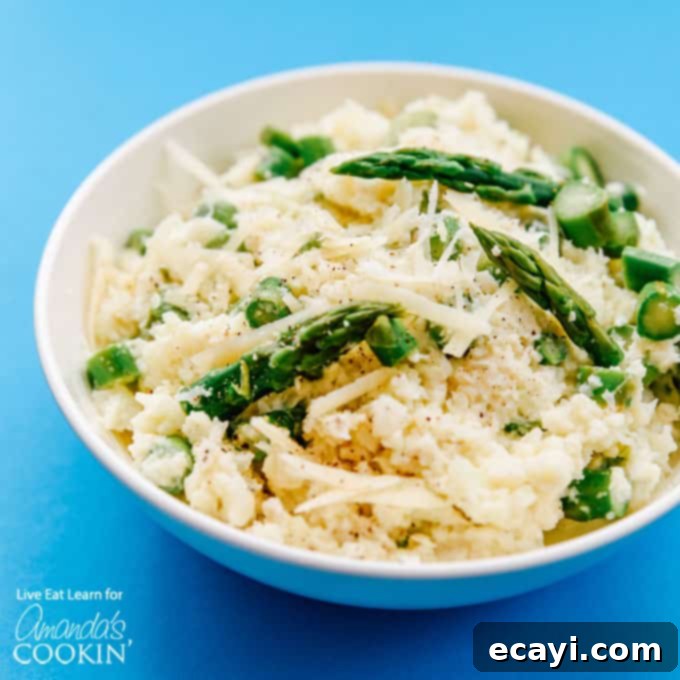
Essential Ingredients for Your Cauliflower Risotto
Creating this magnificent low-carb cauliflower risotto requires a few simple yet impactful ingredients. Each component plays a crucial role in building the rich flavors and creamy texture that makes this dish so irresistible. Here’s a closer look at what you’ll need to gather:
- 1 head of cauliflower: The star of our show! Choose a firm, white head without blemishes. This will be transformed into our “rice” base.
- 1 Tbsp olive oil: For sautéing aromatics and adding a touch of healthy fat and flavor.
- 2 Tbsp chopped shallot: Shallots provide a delicate, sweet onion flavor that forms a perfect aromatic foundation.
- 1 clove garlic, minced: Essential for that unmistakable savory depth that complements almost any Italian-inspired dish.
- 1 cup vegetable broth: The liquid foundation that infuses our cauliflower rice with savory goodness. Opt for a low-sodium variety to control seasoning.
- ½ cup grated parmesan: This adds a salty, umami-rich, and undeniably cheesy element that is crucial for risotto’s signature taste.
- ¼ cup heavy cream: While we rely on pureed cauliflower for much of our creaminess, a touch of heavy cream adds luxurious richness and a silky mouthfeel.
- Salt and pepper, to taste: Basic seasonings to enhance all the vibrant flavors.
- Optional: asparagus: A fantastic addition for color, texture, and seasonal flavor. We’ll discuss more customization options below!
Recommended Kitchen Tools to Make it Easier
Having the right tools can make preparing your cauliflower risotto even more enjoyable and efficient. While not all are strictly necessary, they can certainly simplify the process:
- Food processor: Invaluable for quickly and uniformly transforming a head of cauliflower into “rice.”
- Large sauté pan: Essential for even cooking of the cauliflower rice and accommodating all the ingredients for mixing.
- Wooden spatula: Ideal for stirring and scraping the bottom of the pan without damaging its surface.
- Measuring cups and spoons: For precise ingredient measurements, ensuring consistent results every time.
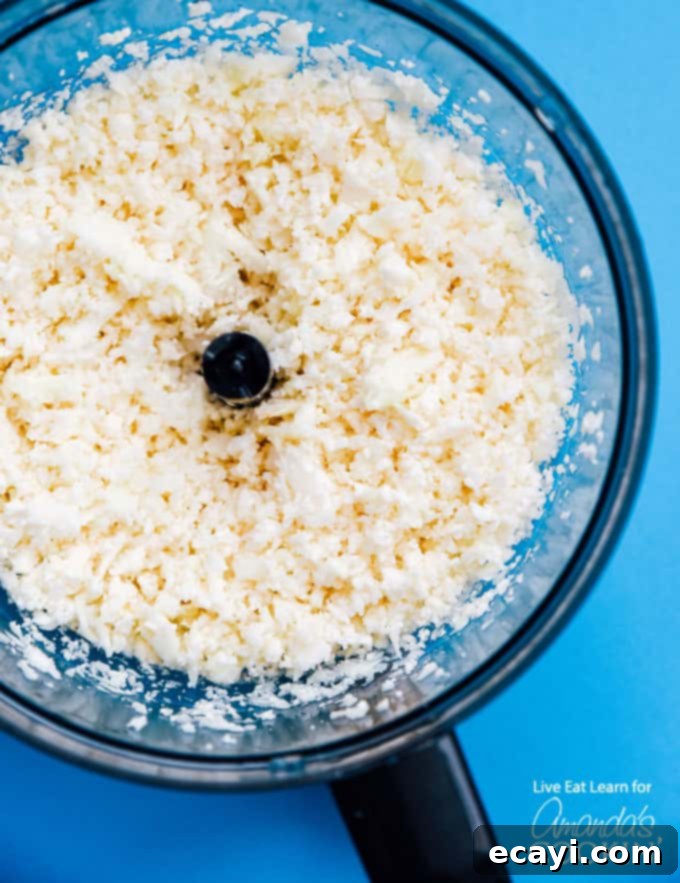
Crafting Your Perfect Cauliflower Risotto: Step-by-Step
We’re focusing on a wonderfully basic yet incredibly flavorful version of this cauliflower risotto. The beauty of this recipe lies in its simplicity and adaptability, allowing you to easily adjust flavors and add ingredients to mimic your favorite traditional risottos. Think along the lines of Lemon Basil Risotto, Gorgonzola Risotto, or a hearty Creamy Mushroom Risotto! For this particular rendition, I opted to include some tender sautéed asparagus, a perfect choice since it’s spring and prime asparagus season.
But let’s not digress too much; making this Cauliflower Rice Risotto is surprisingly straightforward and much quicker than its traditional counterpart. Here’s how you do it:
- Prepare Your Cauliflower Rice: The first crucial step is to transform your head of cauliflower into “rice.” You can achieve this using either a food processor, pulsing the florets until they resemble grains of rice, or by grating them with a box grater. Aim for a consistent texture that’s not too fine (which can become mushy) and not too chunky (which won’t cook evenly).
- Sauté the Aromatics: In a large sauté pan, heat your olive oil over medium heat. Add the chopped shallot and minced garlic. Sauté them gently until the shallot softens and becomes translucent, and the garlic is fragrant – typically just a few minutes. Be careful not to burn the garlic!
- Cook the Cauliflower Rice: Stir the prepared cauliflower rice into the pan with the aromatics. Pour in the vegetable broth. Cover the pan and let it simmer for about 10 minutes, or until the cauliflower is tender. Unlike traditional rice, cauliflower doesn’t need to absorb all the liquid; it just needs to cook through.
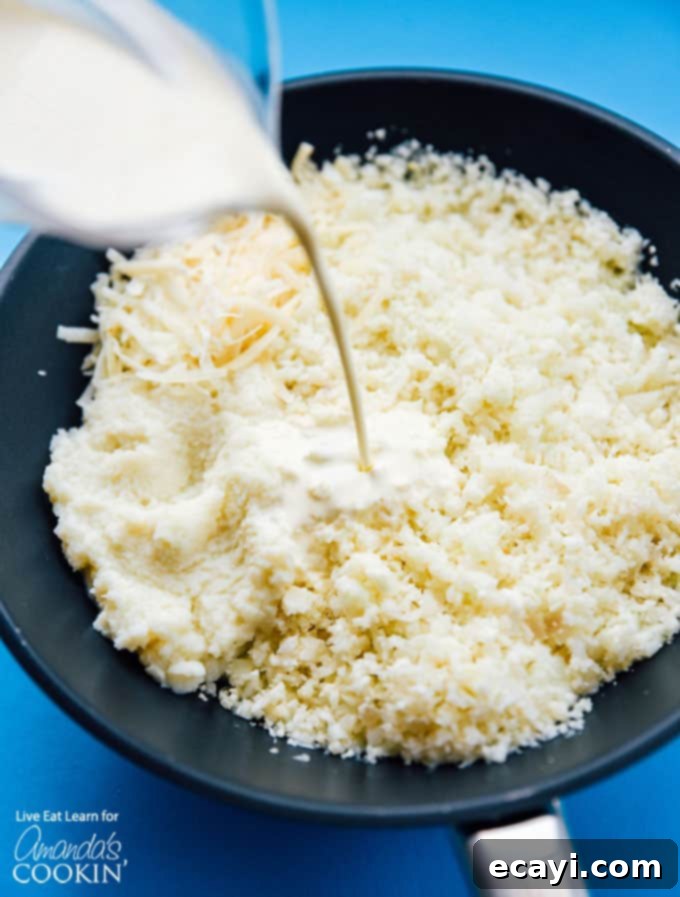
Then comes the secret to achieving an even creamier, yet still healthy, risotto texture. This clever technique provides richness without needing to add excessive amounts of heavy cream:
- The Creaminess Secret: Puree a Portion: Scoop approximately ¼ of the cooked cauliflower mixture into a blender or a small food processor. Puree it until it becomes completely smooth and creamy. This pureed cauliflower will act as a natural thickener and binder. Meanwhile, gently drain any excess water from the remaining ¾ of the cauliflower rice still in the pan. This prevents your risotto from becoming watery.
- Combine and Finish: Stir the pureed cauliflower back into the main batch of cauliflower rice in the sauté pan. This is where the magic happens, transforming the texture. Next, stir in the grated parmesan cheese and the heavy cream. These ingredients melt into the mixture, adding incredible depth and richness. Taste the risotto and season generously with salt and pepper as needed.
- Add Your Optional Extras: Finally, if you’re using them, mix in your optional extras. As mentioned, sautéed asparagus is a fantastic choice, but feel free to get creative with other vegetables or even a cooked protein.
That’s it, friends! In significantly less time and with far fewer carbs, you’ve got a luxurious, low-carb Cauliflower Risotto coming your way! It’s an ideal meal for those craving comfort food that aligns with health-conscious eating.
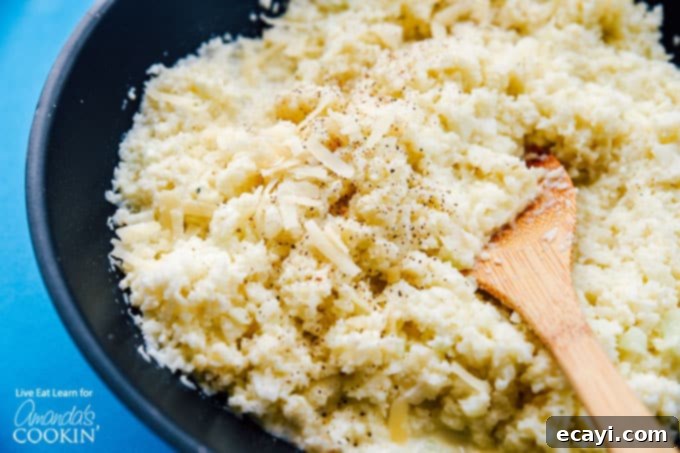
Customization Ideas for Your Cauliflower Risotto
One of the best things about risotto, whether traditional or low-carb, is its incredible versatility. Don’t be afraid to experiment with different flavors and ingredients to make this recipe truly your own:
- Mushrooms: Sauté sliced mushrooms (cremini, shiitake, or a wild mix) before adding the shallots for an earthy, umami-rich mushroom risotto.
- Spinach or Kale: Wilt in a handful of fresh spinach or finely chopped kale at the very end for an extra boost of greens.
- Sun-Dried Tomatoes: Chopped sun-dried tomatoes add a lovely concentrated sweet and tangy flavor.
- Lemon Zest & Fresh Herbs: A squeeze of fresh lemon juice and some lemon zest, along with chopped fresh basil, parsley, or chives, can brighten up the entire dish.
- Spicy Kick: A pinch of red pepper flakes can add a subtle warmth if you like a bit of heat.
- Proteins: For a more substantial meal, stir in cooked chicken (shredded or diced), shrimp, or even some crispy bacon bits.
- Other Cheeses: While Parmesan is classic, a touch of creamy goat cheese, crumbled feta, or a sharp cheddar could also be delicious.
Serving Suggestions for a Complete Meal
This cauliflower risotto is hearty enough to stand alone as a main course, especially when you add some optional protein or extra vegetables. However, it also pairs beautifully with other dishes:
- Serve alongside a simple grilled chicken breast or pan-seared salmon for a balanced meal.
- A crisp green salad with a light vinaigrette makes a refreshing counterpoint to the creamy risotto.
- A side of roasted vegetables like broccoli, Brussels sprouts, or extra asparagus can round out the plate.
- For a truly Italian experience, consider serving it with a glass of dry white wine.
Storage and Reheating Tips
Leftover cauliflower risotto can be a delicious and convenient meal later on. Here’s how to best store and reheat it:
- Storage: Store any leftover risotto in an airtight container in the refrigerator for up to 3-4 days.
- Reheating: To reheat, gently warm the risotto in a saucepan over medium-low heat, adding a splash of vegetable broth or water to help loosen it up and restore its creamy consistency. Stir occasionally until heated through. Alternatively, you can microwave it in short bursts, stirring in between. Be careful not to overcook, as cauliflower can become mushy.
Frequently Asked Questions About Cauliflower Risotto
Can I make this recipe vegan or dairy-free?
Yes! To make it vegan or dairy-free, substitute the heavy cream with full-fat coconut milk (for creaminess) or a dairy-free cooking cream. Replace the parmesan cheese with a nutritional yeast blend for a cheesy flavor, or use a high-quality dairy-free parmesan alternative.
What if my cauliflower risotto is too watery?
Cauliflower naturally contains a lot of water. If your risotto seems too watery after cooking, it likely means you didn’t drain enough liquid after simmering the cauliflower rice. You can try simmering it uncovered for a few extra minutes to allow more moisture to evaporate. The pureeing step also helps to thicken it, but ensuring most excess liquid is removed before adding cream and cheese is key.
Can I use pre-riced cauliflower?
Absolutely! Using pre-riced cauliflower (fresh or frozen) is a fantastic time-saver. If using frozen, thaw it first and press out any excess moisture before cooking to prevent a watery risotto. Adjust cooking times slightly as pre-riced cauliflower may cook faster.
Is this recipe suitable for meal prepping?
Yes, cauliflower risotto is a great option for meal prepping. It reheats well, as described above. Prepare a larger batch at the beginning of the week and portion it out for quick, healthy lunches or dinners.
Can I freeze cauliflower risotto?
While you can technically freeze it, the texture of cauliflower can change upon thawing, potentially becoming softer. If you do freeze it, ensure it’s in an airtight container for up to 1-2 months. Reheat gently from frozen or thawed, adding liquid as needed, but be aware the texture might not be as firm as freshly made.
More Delicious Cauliflower Recipes to Explore
If you’re loving the versatility of cauliflower, here are some other fantastic recipes to add to your repertoire:
- Cauliflower Pizza Crust
- Mashed Cauliflower (a great potato substitute!)
- Cauliflower Copycat Chipotle Rice
- General Tso’s Cauliflower (a vegetarian take on a classic)
- Whole Roasted Cauliflower
- Crockpot Creamy Cauliflower Soup
- Sticky Garlic Cauliflower
- Cauliflower Casserole
- Mexican Cauliflower Rice
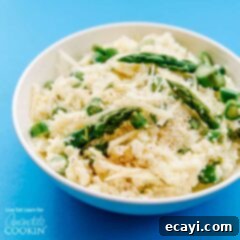
Cauliflower Risotto
IMPORTANT – There are often Frequently Asked Questions within the blog post that you may find helpful. Simply scroll back up to read them!
Print It
Pin It
Rate It
Save ItSaved!
Ingredients
- 1 head of cauliflower
- 1 Tbsp olive oil
- 2 Tbsp shallot chopped
- 1 clove garlic minced
- 1 cup vegetable broth
- ½ cup grated parmesan
- ¼ cup heavy whipping cream
- Salt and pepper to taste
- Optional: asparagus
Instructions
-
Rice the cauliflower by either blitzing chunks of it in a food processor or grating with a box grater until it resembles small grains of rice.
-
Heat olive oil in a large saute pan over medium heat. Add chopped shallot and minced garlic, and cook until the shallot is tender and translucent (about 2-3 minutes). Stir in the riced cauliflower and vegetable broth. Cover and cook for 10 minutes, or until the cauliflower is tender.
-
Scoop about ¼ of the cooked cauliflower mixture into a blender or food processor and puree until completely smooth and creamy. Carefully drain any excess water from the remaining ¾ of the cauliflower rice in the pan.
-
Stir the pureed cauliflower back into the cauliflower rice, along with the grated parmesan cheese and heavy cream. Mix well until everything is combined and creamy. Taste and add salt and pepper, as needed, to achieve your desired seasoning.
-
Optionally stir in pre-sautéed asparagus (or your favorite cooked vegetable) or a cooked protein (like shredded chicken or shrimp) for added flavor and substance. Serve immediately.
Nutrition
The recipes on this blog are tested with a conventional gas oven and gas stovetop. It’s important to note that some ovens, especially as they age, can cook and bake inconsistently. Using an inexpensive oven thermometer can assure you that your oven is truly heating to the proper temperature. If you use a toaster oven or countertop oven, please keep in mind that they may not distribute heat the same as a conventional full sized oven and you may need to adjust your cooking/baking times. In the case of recipes made with a pressure cooker, air fryer, slow cooker, or other appliance, a link to the appliances we use is listed within each respective recipe. For baking recipes where measurements are given by weight, please note that results may not be the same if cups are used instead, and we can’t guarantee success with that method.
